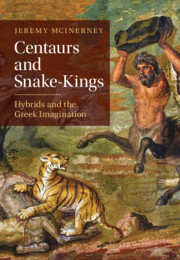Book contents
- Frontmatter
- Dedication
- Contents
- List of Figures
- Preface
- Acknowledgments
- Spelling and Orthography
- 1 Introduction: Encountering the Sphinx
- 2 ‘Welcome to Athens’: Theories of Hybridity
- 3 Hybrids around the Corrupting Sea
- 4 Hybrids, Contact Zones and Margins
- 5 Heads or Tails: Gorgons, Satyrs and Other Composites
- 6 Centaurs and Other Horses
- 7 Snakes and the Perils of Autochthony
- 8 Hermaphrodites and Other Bodies
- 9 Adynata, Ethnography and Paradox
- 10 Conclusions
- Bibliography
- Index
4 - Hybrids, Contact Zones and Margins
Published online by Cambridge University Press: 16 August 2024
- Frontmatter
- Dedication
- Contents
- List of Figures
- Preface
- Acknowledgments
- Spelling and Orthography
- 1 Introduction: Encountering the Sphinx
- 2 ‘Welcome to Athens’: Theories of Hybridity
- 3 Hybrids around the Corrupting Sea
- 4 Hybrids, Contact Zones and Margins
- 5 Heads or Tails: Gorgons, Satyrs and Other Composites
- 6 Centaurs and Other Horses
- 7 Snakes and the Perils of Autochthony
- 8 Hermaphrodites and Other Bodies
- 9 Adynata, Ethnography and Paradox
- 10 Conclusions
- Bibliography
- Index
Summary
After looking at the Mediterranean as a zone characterized by the movement of goods, people and ideas, this chapter examines the sea as the element from which hybrids arise, such as Skylla, Nereus, the Nereids and monsters of Hesiod’s Theogony. These hybrids give expression to the anxieties of Greek speakers on the move. Contact zones like Sicily stimulated a powerful response from Greek speakers, who were constantly faced with other people, other tongues and other habits. Hybridity emerges as a useful mechanism for envisaging otherness and rendering it manageable, either as monstrous threat or as something in a more muted register: similar, yet at the same time different. It is this polarity of similarity and difference that is the pendulum swinging through Archaic Greek culture. Two places of particularly rich cultural encounters, Naukratis and Samos, illustrate how the categories of exotic and hybrid overlap. Even more complicated is Cyprus, demonstrating the most intense cultural layering in the eastern Mediterranean. Here where EteoCypriots, Mycenaean Greeks, Assyrians and Phoenicians all mingle, hybridity was a recurring feature of the island’s culture.
Keywords
- Type
- Chapter
- Information
- Centaurs and Snake-KingsHybrids and the Greek Imagination, pp. 92 - 135Publisher: Cambridge University PressPrint publication year: 2024

